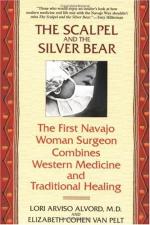|
This section contains 573 words (approx. 2 pages at 400 words per page) |

|
The Scalpel and the Silver Bear Summary & Study Guide Description
The Scalpel and the Silver Bear Summary & Study Guide includes comprehensive information and analysis to help you understand the book. This study guide contains the following sections:
This detailed literature summary also contains Topics for Discussion and a Free Quiz on The Scalpel and the Silver Bear by Lori Alvord.
The Scalpel and the Silver Bear is the autobiography of Dr. Lori Arviso Alvord, the first female Navajo doctor in the United States. Alvord was raised in a small town named Crownpoint on a Navajo reservation adjacent to New Mexico. She grew up the daughter of a Navajo man and a white, blond woman, feeling torn between Navajo and modern American worlds. The book tells the story of Alvord's attempt to integrate the core insights and wisdom of her two cultural traditions. She intends her book to serve two other purposes as well: to tell the story of how one Navajo broke the glass ceiling and to illustrate the medical knowledge latent in Navajo rituals and taboos.
Alvord argues that modern medicine has lost any sense of spirituality. One of the most intimate things you can do with a person, in Alvord's opinion, is to cut them open and change what is inside of them. Navajos traditionally do not allow themselves to be cut open and are afraid to touch the dead. Alvord was thus raised with a profound sense of reverence about the body and found her interest in surgery coming into conflict with it.
Alvord became convinced early in her career that the Navajo philosophy of the harmony of all things, The Beauty Way, could be used to aid in the healing process for her patients, especially Navajo ones. She argues throughout the book that hospital staff should try to form communities of care, to integrate families and communities into patient care and to show respect for the culture and histories of patients.
The Scalpel and the Silver Bear has fourteen chapters. Chapter 1, Chantways, relates Navajo health culture to the reader and introduces Dr. Alvord's practice, birth and childhood, along with the histories of her grandmother, mother and father. Chapter 2, Walking the Path between Worlds, discusses the relationship between Alvord's Navajo culture and her experience in college. Chapter 3, Journey Down the Medicine Path, explains how Alvord decided to become a surgeon and how her desire both amplified and alienated her from her connection with her Navajo roots.
Chapter Four, Life Out of Balance, clarifies how Alvord learned to be a better doctor for her Navajo patients and discusses treating her patients for gallbladder problems. Chapter Five, Rez Dogs and Crow Dreams, examines the terrible struggle that many Navajos and Native Americans generally have with alcoholism. Chapter Six, Ceremony Medicine, focuses on the role of the medicine man or woman in Navajo culture and how they often possess wisdom about healing despite being unacquainted with modern medicine. Chapter Seven, Spiritual Surgery, shows Alvord starting to explicitly integrate Navajo philosophy into her medical practice. Chapter Eight, The 'Navajo Plague' discusses a hantavirus epidemic among the Navajo.
Chapter Nine, Two Weddings, explains Alvord's relationship with and marriage to Jon Alvord. Chapter Ten, At the Big Medicine Space, explores Alvord's life at her hospital in Gallup, New Mexico. Chapter Eleven, Do Not Try to Count the Stars, and Chapter Twelve, The Spirit Horse's Bridle, focus on Alvord's pregnancy and her associated visit to a medicine man. Chapter Thirteen, A Knotted Sash, tells the story of her son Kodi's birth. Chapter Fourteen relates the story of Alvord's grandmother Grace's death and her family's decision to leave Gallup for Dartmouth, where Alvord would take up a prestigious position at the medical school and start to integrate her Navajo philosophy into medical practice there.
Read more from the Study Guide
|
This section contains 573 words (approx. 2 pages at 400 words per page) |

|



